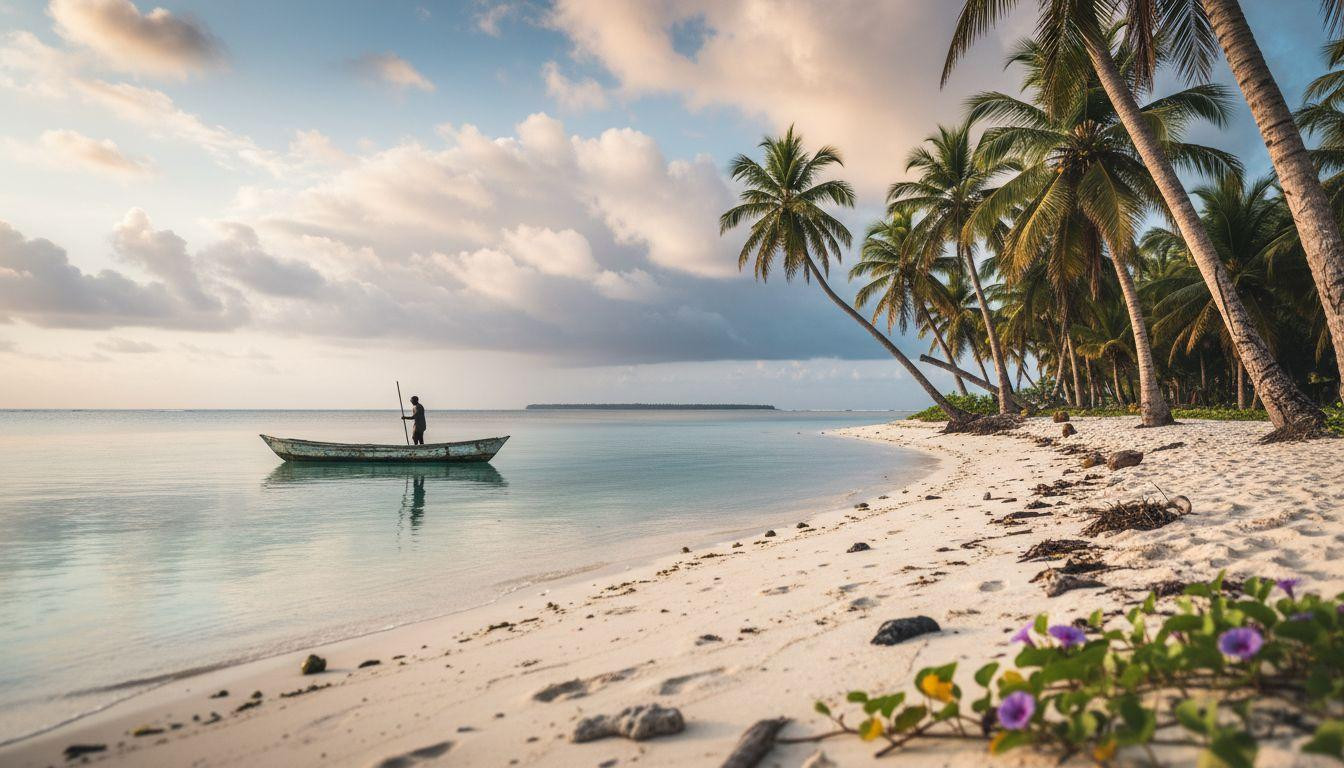Steam rises from your morning coffee at 6:15 AM as turquoise waters catch the first golden light. A wooden pirogue glides silently across Île Sainte-Marie’s lagoon while a humpback whale breaches just 650 feet offshore. This slender 37-mile island off Madagascar’s east coast delivers Caribbean-perfect beaches, 17th-century pirate graveyards, and whale encounters for $60-120/night. Yet it welcomes only 30,000 visitors annually while Zanzibar crowds swell to millions.
Where pirate history meets turquoise paradise
Île Sainte-Marie rests 10 miles off Madagascar’s eastern shore. Access comes via 1-hour Air Madagascar flights from Antananarivo ($185-235) or 2.5-hour ferries from Toamasina ($15-30). The island stretches 37 miles long and 3 miles wide at its narrowest point.
Its coral spine creates sheltered western lagoons that glow turquoise against powdered-sugar beaches. Captain Kidd and other 17th-century pirates used these protected waters as hideouts. The hillside Pirate Cemetery preserves 17 weathered tombstones marked with skull-and-crossbones.
The 1857 Notre Dame de l’Assomption Church rises above Ambodifotatra village. Its red tin roof catches morning light while fishing pirogues prepare for daily work. This coastal rhythm mirrors other Indian Ocean sanctuaries where wooden boats define the dawn.
The island that time preserved
Turquoise waters and coral gardens
The western coastline delivers postcard-perfect tropical beaches. Turquoise shallows fade to deep indigo beyond palm-fringed white crescents. Coral reefs teem with parrotfish, angelfish, and octopus in waters reaching 65-85 feet visibility.
Snorkeling excursions ($40-60/day) reveal underwater gardens where sea turtles glide past brain coral formations. The eastern coast faces open Indian Ocean swells. Dramatic wave breaks crash against volcanic rock formations carved over millennia.
Humpback whale season spectacle
From June to September, humpback whales migrate from Antarctic waters to birth calves. These warm lagoons become nurseries for 40-foot adults and curious newborns. Whale-watching tours ($50-70) bring visitors within regulated distances of breaching families.
Local guides maintain respectful protocols while explaining migration patterns. Marine conservation groups report 92% success rates during peak July season. This natural spectacle rivals Tonga’s whale encounters at half the cost.
Living the authentic island rhythm
Village immersion and rainforest trails
Bicycle rentals ($5/day) allow exploration of coastal villages where wooden houses stand on stilts. Sandy lanes wind between palm groves and vanilla plantations. The Piscine Naturelle offers calm swimming at high tide in sheltered tidal pools.
Inland trails wind through rainforest patches harboring endemic orchids. The “Queen of Madagascar” variety blooms in hidden groves. Guided nature walks ($25-50) reveal chameleons, lemurs, and rare bird species. Morning mist through forest canopies creates ethereal photography opportunities.
Fresh seafood and Malagasy flavors
Waterfront restaurants serve grilled crab, zebu steaks, and fresh reef fish for $5-10/meal. The island’s signature drink blends coconut milk with pastis at sunset gatherings. Local markets offer vanilla pods, hand-carved wooden boats, and woven baskets.
Morning catches arrive directly to beachside grills by 11 AM. Fishermen’s wives prepare traditional “romazava” stew with fresh ingredients. The aroma of grilled seafood mingles with frangipani blossoms in evening breezes.
The comparison nobody mentions
While Seychelles charges $150-300/night for midrange beachfront lodging, Île Sainte-Marie’s eco-lodges deliver similar turquoise views for $60-120/night. Zanzibar welcomes moderate-to-high tourist traffic. This island’s 30,000 annual visitors leave beaches empty most mornings.
The Maldives requires international flights exceeding $1,000. Madagascar’s domestic connection costs $185-235 roundtrip. The tradeoff involves rustic infrastructure and genuine village rhythms instead of resort polish.
This represents discovery travel, not luxury tourism. Authentic Malagasy culture replaces international hotel chains. Local fishing boats outnumber tour operators 20-to-1.
Your questions about Île Sainte-Marie, Madagascar answered
When should I visit and what will it cost?
June-September offers ideal weather (68-81°F, dry season) and humpback whale season. Peak crowds occur July-September but remain modest compared to other Indian Ocean destinations. November-April brings heavier rains and higher humidity (75-88°F).
Midrange budgets work comfortably: $60-120/night lodging, $40-60/day activities, $15-30/day meals. Ferry service from Toamasina costs $15-30. Flights from Antananarivo run $185-235 roundtrip with advance booking.
How does it compare to Zanzibar or Seychelles?
Île Sainte-Marie delivers similar turquoise lagoons and white beaches at 40-60% lower costs than Zanzibar. Far fewer tourists create authentic cultural immersion opportunities. It lacks Seychelles’ luxury polish but offers unique pirate history.
Whale watching provides experiences neither competitor matches during migration season. Village markets and family-run restaurants create genuine local connections impossible in resort destinations.
What makes the pirate history authentic?
The hillside Pirate Cemetery contains 17 confirmed graves with weathered tombstones dating to the early 1700s. Captain Kidd’s connection remains historically debated, but archaeological evidence supports the island’s role as a pirate haven.
The 1857 Notre Dame de l’Assomption Church stands as Madagascar’s oldest, built during French colonial period. Local museums preserve artifacts recovered from shipwrecks and pirate settlements throughout the island.
Dawn breaks at 5:15 AM as golden light illuminates empty white beaches. A wooden pirogue crosses mirror-calm lagoons while palm shadows lengthen across coral sand. This is Île Sainte-Marie: Madagascar’s forgotten island where Caribbean-perfect waters meet 8,000 Malagasy souls and zero cruise ships.
